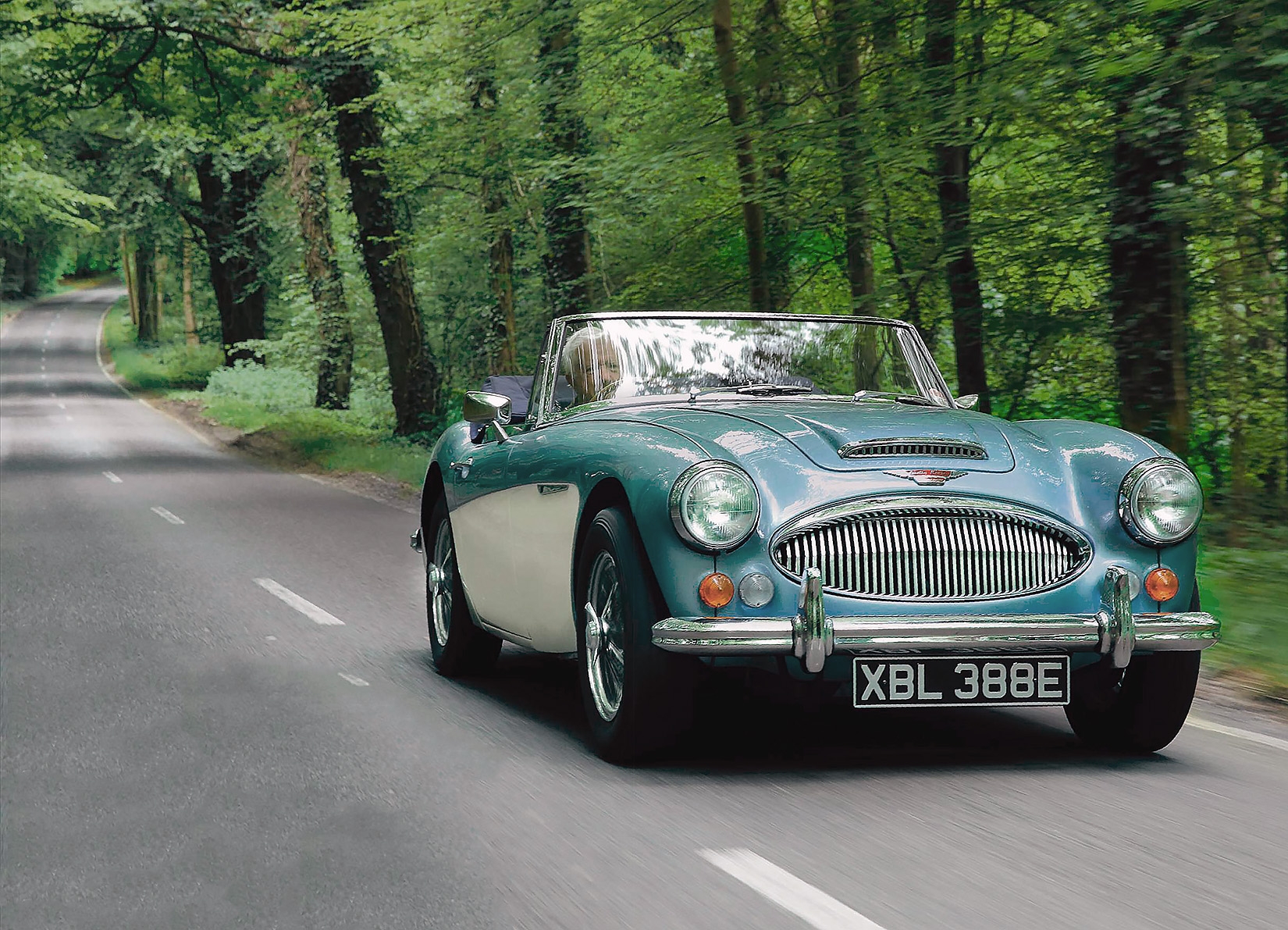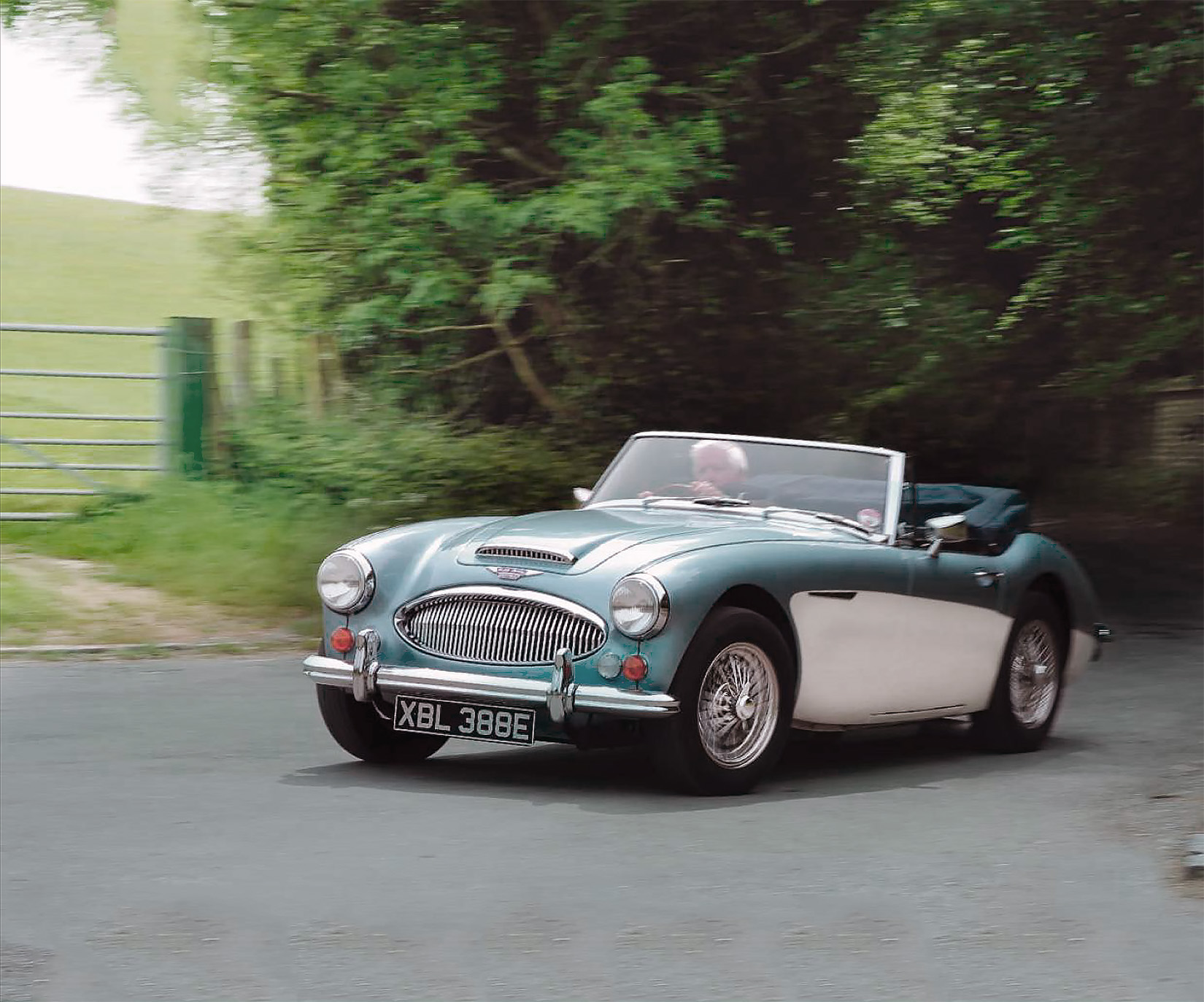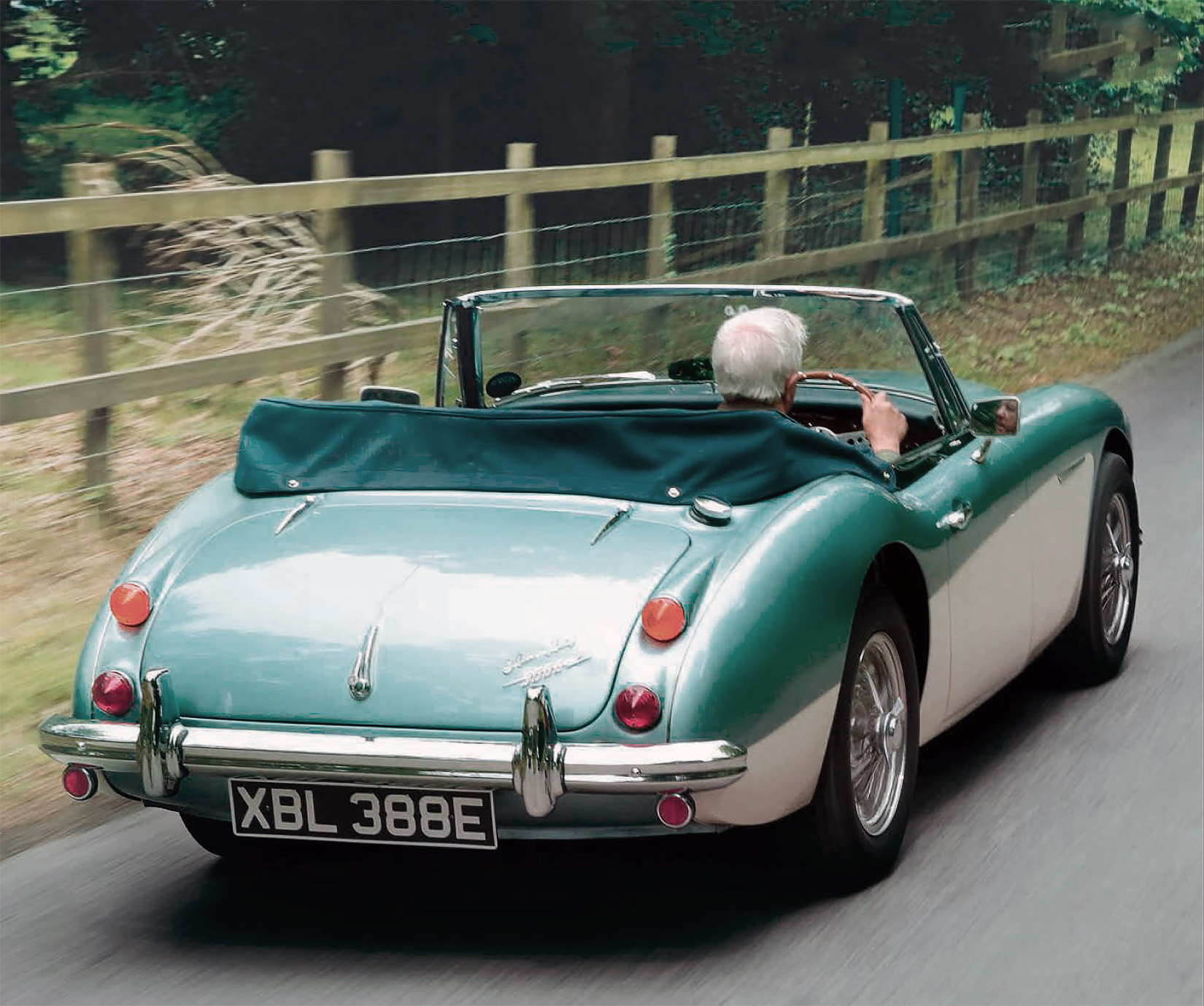
The list – it would be wonderful to own a car like this. Drive-My reader Malcolm Fortnam sent us a wishlist packed with multi-cylindered greats. Would an Austin-Healey 3000 live up to his dream? Words: Ben Field. Photography: Richard Parsons.
Malcolm Fortnum’s driving wish list is packed with six- and eight-cylinder greats, including the Austin-Healey 3000 – so we put him behind the wheel of this Mklll and told him to take it for a spin. It’s the kind of day open cars were made for. The seaside postcard-blue brilliance of the sky frames the green abundance of early summer. The roads are dry and empty. The air is still until the ripe, ripping, palpable exhaust note of an Austin-Healey 3000, barely silenced from inline six to side-exit exhaust, bursts forth from a barn.
On choke, the Austin-Healey wolfs petrol through two rotund SU carburettors, rudely combusting it and running fast. There’s a brief hint of the car’s better manners as the choke is slid home and the engine settles into a mellow idle. The car emerges, flirting with the sunlight, then disappears on a lap of neighbouring barns only to reappear like a Sixties supermodel, composed in the frame, an icon in two-tone and chrome.

All that wood and leather marks this out as a 3000 Mklll, the most luxurious of the Big Healeys
The ignition is switched off, the driver’s door opened and then shut with a satisfyingly solid clunk. Footsteps retreat. Silence returns. Into this silence walks Malcolm Fortnam, Drive-My reader and provider of a list full of sixes and eights. The Austin-Healey 3000 Mklll is one of them. This beautifully restored example belongs to Rawles Motorsport of Upper Froyle, Hampshire. But today its keys belong to Malcolm.
‘Just seeing the car sitting here in the sun brings back a wave of nostalgia for that heyday period of British sports cars in the Fifties and Sixties,’ he says. ‘It has those beefy good looks without looking aggressive. As a schoolboy, when I drew a picture of a sports car it looked just like this. It is one of the few sports cars that actually still looks very good with the hood up – but I don’t think we’ll need to worry about that today.’
With that, Malcolm doesn’t leap straight into the driver’s seat and find the first road out of here; instead he steps back to further appreciate his charge. ‘Some sports cars became a bloated caricature of the pure original with each generation, but the 3000 didn’t grow in size, it didn’t lose its character, it improved on it,’ he says.
Leaning over the gently curved screen to appreciate the interior he adds, ‘I can understand some people preferring the more minimalist trim of early models, but I have always been a fan of wood and leather. I think the Mklll looks superb inside and out.’
Malcolm swings the door open, steps inside and sits down. He takes his time to make fine adjustments to seat and mirrors, rests his hands on the wheel, presses pedals (‘closely spaced, offset to the right’), notes the position of dials and switches (‘indicators on the wheel boss, overdrive switch close to the wiper switch’). Thirty-five years teaching car craft as a driving instructor makes this routine second nature. I’ve got a feeling I’m in for a comfortable drive.
The engine, which was so thoughtfully warmed up for us earlier, stirs back into that mellow idle on the first turn of the key. We’re off. Malcolm sets off out of Upper Froyle. ‘It’s great to be in an open car again,’ he says with a smile. ‘First gear is long, and the steering is quite heavy at low speeds.’ We just catch second at the end of a lane then turn right on to the A31, mellow changing to bellow as engine speed rises. ‘This is such a torquey engine,’ says Malcolm. ‘Road-tests said it would do 60mph in less than ten seconds, and 100mph in 23 seconds. The 0-100mph figure is still impressive today.’ Malcolm’s clearly been doing his homework and this freshly rebuilt and balanced engine isn’t about to disappoint. There is some dispute that all original 3000 Mkllls could deliver on the quoted 162lb ft of torque and 150bhp promise straight out of the factory. But there’s no doubt that a well-sorted one will give that and more, with some race-spec cars closing in on 260bhp.

‘Second, third and fourth gear ratios are all very close,’ says Malcolm. ‘This keeps the engine speed right in the torque band so it will still easily keep up with most modern cars.’ He flips the far-right switch on the facia down from normal to overdrive, deftly avoiding the wiper toggle in the process. Overdrive cuts in smoothly, the engine speed drops and the car changes character from hard- charging sports car to journey-consuming GT in an instant.
The steering has plenty of feel to it – tactile and satisfying. It allows you to form a close relationship with the car
Peeling off towards East Worldham, Malcolm doesn’t touch the gearstick for the necessary downchange. ‘It’s really useful to be able to change ratios just by flicking out of overdrive,’ he says. Small stones ping off the exhaust as the road surface deteriorates from fine to patchy with outbreaks of potholes. There’s the briefest shimmy where quarterlights and windscreen meet as it rides the rougher sections, but that’s it for scuttle shake. It’s a condition that spoils some Sixties sports cars, but not this one. ‘It’s clear that this car has been restored to a superb standard,’ says Malcolm. ‘Apart from the mild scuttle shake, there are no annoying rattles or squeaks.’
South towards Liss and across to Midhurst the road climbs, dips and curves its way across the South Downs. ‘The steering has plenty of feel to it – tactile and satisfying. It allows you to form a close relationship with the car,’ says Malcolm. ‘The brake pedal is heavy but, like the steering, it gives feedback. And the brakes work well.’

Handling is sweet, despite that hefty straight-six
A fast run on the unrestricted sections between the villages that lie between Midhurst and Singleton, and we jink left and roar up the hill to Goodwood Motor Circuit. After tea in the Aero Club Cafe I’m in the driver’s seat and quickly reminded of the relatively high driving position. On the road there’s no buffeting; driving caps and hair stay in place, conversation isn’t a problem. Like the steering and the braking, the clutch also demands full driver involvement. The clutch pedal is weighty and expects to be properly pressed to the floor before allowing a gearchange. On the move, first gear is incredibly long – one contemporary road-tester squeezed more than 40mph out of it. I’ve no intention of repeating that, but change up at 15-20mph and it’s only the torque of the engine that prevents a lull in performance. I learn to hang on to first a little longer and bask in the closely spaced sportiness of the remaining ratios.
A thin-rimmed Moto-Lita wheel, all rivets and polished wood, jiggles as the road wheels fidget over imperfections in the road. On straights, in bends, accelerating and under braking, the steering wheel is the consummate communicator.
The ‘Big’ in Big Healey is the 2912cc engine, an enormous in-line six-cylinder. Its weight over the front wheels adds to the steering feel, but Austin-Healey got its position in the chassis spot-on. You can feel the weight of the engine out front, but the car won’t plough a straight line when you show it a fast corner. The ride is firm, but not uncomfortable. These last-of-the-line cars gained a 25mm ride-height advantage over earlier models and softer springs too. Good damping from lever arms keeps the springs in check and there’s very little body roll.
Malcolm reclaims the driver’s seat and I ask him if it would still make it on to his list. ‘It did everything I hoped it would. It would be wonderful to own this, even just to look at it on the driveway. Taking it out for exercise would need the right day, the right road and a driver in the right mood.’
Some people suit certain cars. Malcolm could have been made for the Austin-Healey 3000. He fits it, he looks right in it and he drives it beautifully, with never a fluffed change or an ill-taken corner. Today we’ve been back in the Sixties, and this fine British sports car is a perfect companion.
Thanks to: Andrew Cluett, Rawles Motorsport, plus Jamie O’Leary and lan Stevens at Goodwood.
WANT A DRIVE?
Drive-My will make a dream drive happen for one reader in every issue. All you need to do to be in the reckoning Is to send us your list of the ten cars you dream most of driving, plus a CV of the Drive-My you’ve owned, then fire It off to us. You’ll need to be prepared for the possibility of long distance travel and an early-morning start, but the experience will be unforgettable.
RESTORING A BIG HEALEY

Austin-Healey restoration can easily eat your wallet
THE ROAD TO HEALEY BLISS
If you’re looking to have a 3000 restored, getting the right car and the right restorer before it all kicks off is the key to the best result
Handsome, fast and usable, Big Healeys have always commanded relatively big money. Investors putting money into cars has seen the value of Austin-Healeys and their ilk rise significantly since the early years of the recession.
Still think you can get into a good one for about £30,000? Sorry – you can pay that for a driving restoration project, but the very best restored cars can now command £80,000.
If you’re starting at the restoration end of the market, Andrew Cluett from marque specialist Rawles Motorsport suggests that you drive the car if possible.
‘Severe scuttle shake means structural rot has taken hold,’ he says. Bear in mind a full restoration costs up to £50,000 at a specialist, but Andrew adds, ‘Get the restoration done properly by a firm with a good track record and you won’t lose money on the car if you come to sell it.’
‘Get the restoration done by a company with a good record and you won’t lose money on the car’
The low-revving engines are very robust. ‘I’ve seen them with 200,000 miles and zero oil pressure but still running,’ says Andrew. A rebuild to bring the engine to genuine 150bhp spec and beyond costs £10,000. For that you’ll get a fully balanced unit with forged pistons that’s built to last. Porting and gas-flowing the cylinder head can raise the power output to 180bhp.
With the price of Big Healeys as they are, the temptation to make a quick buck from tartcd-up rubbish is as strong now as it was back in the classic car boom of the Eighties. For as little as £250 you can get a marque expert to check a would-be buy before you hand over your cash. At the very least you’re going to get that figure back on haggling points, but you could end up saving a lot more.
‘I went to see a car for a client that was up for £50,000,’ says Andrew. It looked pretty, but it was rotten and worth a fraction of the asking price.’ Once you’ve got your Big Healey, relatively cheap, bolt-on modifications that can make a big difference to the way it drives include smooth-flowing inlet manifold and an uprated exhaust system. ‘The standard 2in carburettor inlet manifolds have abysmal gas flow,’ says Andrew. ‘Where the carburettor mounts, the manifold pipe is a square section; just replacing this with a manifold that matches the shape of the carburettor outlets reduces turbulence in the inlet and helps the engine to breathe.’
THE EVOLUTION
3000 BN7 TWO-SEAT ROADSTER /BT7 TWO PLUS TWO 1959-1961
The Austin-Healey 3000 is launched. It’s effectively a rebadged 100/6 with a larger engine (2912cc compared to the 100/6’s 2639cc). The extra capacity, coupled with a longer-duration camshaft, increases torque and power, with acceleration and top speed improvements over the outgoing 100/6. There’s a stronger clutch and gearbox, and disc brakes replace drums at the front.
3000 Mkll BN7 TWO-SEAT ROADSTER IBT7 TWO PLUS TWO 1961-1962
The Mkll gets three 1.5in SU carburettors in place of the pair of 1.75in SUs on the first model. Austin-Healey claims an 8-10bhp power hike, but the main reason is that it allows the company to exploit a homologation loophole and put a matching number of Weber 45 DCOE carburettors on its competition cars. Grille slats go vertical, a distinct styling shift from the horizontal slats of the Mkl.
3000 Mkll ‘A’ BJ7 SPORTS CONVERTIBLE 1962-1963
BJ7 Mkll Convertible (sometimes referred to as the MkllA) uses the two- plus-two seating set up of the BT7 and replaced both that and the BN7. It features a curved windscreen, wind-up windows with quarterlights and a better-folding hood. The engine reverted to twin 1.75in SU carburettors, but other engine changes resulted in almost identical bhp output and only a small loss of torque.
3000 Mklll BJ8 PHASE 1 1963-1964 TWO PLUS TWO
Wooden dashboard and locking glovebox replace the vinyl-clad dash of previous models, and there’s a centre console covering the transmission tunnel. The hinged rear seat squab converts to a luggage shelf. Further changes to camshaft duration, stronger valve springs, a dual exhaust system and a move to twin 2in SU carburettors delivers 148bhp, produced 500rpm higher up the rev range. A servo is now standard.
3000 Mklll BJ8 PHASE 2 1964-1968 TWO PLUS TWO
The original Mklll only lasts around six months before Phase II revisions produce the best 3000 of all. A new chassis with reprofiled members increases ground clearance by lin (25mm) and softer springs bring ride improvements. Trailing radius arms replace the Panhard rod on the rear axle. Instant external identifiers are provided by separate front and rear indicator units and push-button rather than lever door handles.
| Car | Austin-Healey 3000 |
| Sold/number built | |
| Construction |
steel body |
| Engine |
2912cc, in-line six-cylinder, ohv, twin 2in SU HD8 carburettors |
| Max power |
148bhp @ 5250rpm |
| Max torque |
173lb ft @ 3000rpm |
| Transmission |
Four-speed manual, overdrive on third and fourth gears |
| Drive | driving rear wheels |
| Suspension: | |
| front |
independent with wishbones, coil springs, anti-roll bar, lever arm dampers |
| rear |
live rear axle, semi-elliptic leaf springs, trailing radius arms, lever arm dampers |
| Steering |
Cam and peg steering box |
| Brakes |
Discs front, drums rear |
| Wheels | – |
| Length | – |
| Width | – |
| Height | – |
| Wheelbase | – |
| Weight |
2604lb (1182kg) |
| 0-62mph | 9.8sec |
| Top speed | 120mph |
| Mpg | 22 |
| Price new | £1126 8s 2d (with taxes) |
| Value now | £85,000 |





